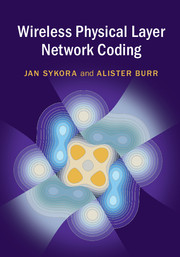Book contents
- Frontmatter
- Contents
- Preface
- Mathematical Symbols
- Abbreviations
- Part I Motivation and Gentle Introduction
- Part II Fundamental Principles of WPNC
- Part III Design of Source, Relay, and Destination Strategies
- 6 NCM and Hierarchical Decoding Design for H-MAC
- 7 NCM Design and Processing for Parametric Channels
- 8 NCM Design for Partial HSI and Asymmetric H-MAC
- 9 Joint Hierarchical Interference Processing
- 10 WPNC in Complex Stochastic Networks
- Appendix A Background Theory and Selected Fundamentals
- References
- Index
7 - NCM Design and Processing for Parametric Channels
from Part III - Design of Source, Relay, and Destination Strategies
Published online by Cambridge University Press: 01 February 2018
- Frontmatter
- Contents
- Preface
- Mathematical Symbols
- Abbreviations
- Part I Motivation and Gentle Introduction
- Part II Fundamental Principles of WPNC
- Part III Design of Source, Relay, and Destination Strategies
- 6 NCM and Hierarchical Decoding Design for H-MAC
- 7 NCM Design and Processing for Parametric Channels
- 8 NCM Design for Partial HSI and Asymmetric H-MAC
- 9 Joint Hierarchical Interference Processing
- 10 WPNC in Complex Stochastic Networks
- Appendix A Background Theory and Selected Fundamentals
- References
- Index
Summary
Introduction
This chapter is dedicated to the NCM design and receiver processing that we need to use to properly address the effects of the channel parametrization. This generally leads to various synchronization and equalization techniques or NCM design resistant (at least to some extent) against the parametrization. However, all these must properly reflect two fundamental WPNC characteristics that dominate to any H-MAC channel. First, the received signals from component nodes interact in a common signal space. Second, the target of our effort at the receiving node is to decode the H-codeword and the receiver node is neither interested nor potentially having access to the individual component codebooks.
Section 7.2 deals with a straightforward task of estimating the channel state in the H-MAC channel. We concentrate on a pilot-based technique. The goal is, if possible, to avoid the orthogonal pilot signals. The usage of orthogonal pilots would require additional resources dedicated purely to pilots that also might require an excessive resource management in large networks. It also somewhat goes against the WPNC paradigm of sharing the signal space among all H-MAC component signals. We will see that a complete sharing of pilot signal space among component nodes creates fundamental problems, which can be somewhat reduced by a partial sharing or under some specific channel state conditions.
Section 7.3 extends the scope for frequency selective channels and also, as a special case, for frequency flat channels with uneven delays among H-MAC components. We show that OFDM type of NCM waveform can easily turn this case, similarly to classical single-user systems, into the set of multiplexed flat fading sub-carrier channels. This appears as an intuitive step. However, rather more important, and less obvious, is the fact that it solves the case of uneven delays. This is specific for WPNC and cannot be ignored. We will show that NCM with OFDM waveform easily accepts arbitrary timing misalignment among the signals received from H-MAC components approximately up to the length of a cyclic prefix.
Finally, in Section 7.4, we analyze the conditions under which the NCM could be made resistant to various forms of H-MAC parametrization. We will define various levels of resistance, ranging from complete invariance w.r.t. some channel parameters, to the uniformly most powerful performance.
- Type
- Chapter
- Information
- Wireless Physical Layer Network Coding , pp. 207 - 225Publisher: Cambridge University PressPrint publication year: 2018



